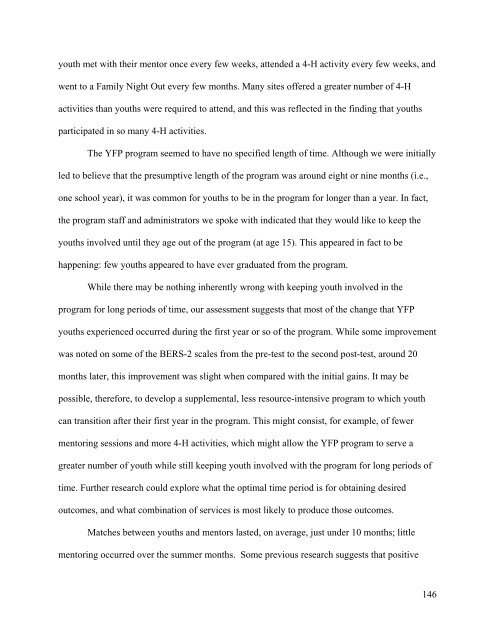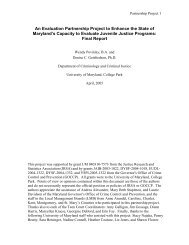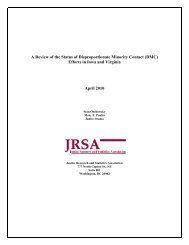A Process and Outcome Evaluation of the 4-H Mentoring/ Youth and ...
A Process and Outcome Evaluation of the 4-H Mentoring/ Youth and ...
A Process and Outcome Evaluation of the 4-H Mentoring/ Youth and ...
You also want an ePaper? Increase the reach of your titles
YUMPU automatically turns print PDFs into web optimized ePapers that Google loves.
youth met with <strong>the</strong>ir mentor once every few weeks, attended a 4-H activity every few weeks, <strong>and</strong><br />
went to a Family Night Out every few months. Many sites <strong>of</strong>fered a greater number <strong>of</strong> 4-H<br />
activities than youths were required to attend, <strong>and</strong> this was reflected in <strong>the</strong> finding that youths<br />
participated in so many 4-H activities.<br />
The YFP program seemed to have no specified length <strong>of</strong> time. Although we were initially<br />
led to believe that <strong>the</strong> presumptive length <strong>of</strong> <strong>the</strong> program was around eight or nine months (i.e.,<br />
one school year), it was common for youths to be in <strong>the</strong> program for longer than a year. In fact,<br />
<strong>the</strong> program staff <strong>and</strong> administrators we spoke with indicated that <strong>the</strong>y would like to keep <strong>the</strong><br />
youths involved until <strong>the</strong>y age out <strong>of</strong> <strong>the</strong> program (at age 15). This appeared in fact to be<br />
happening: few youths appeared to have ever graduated from <strong>the</strong> program.<br />
While <strong>the</strong>re may be nothing inherently wrong with keeping youth involved in <strong>the</strong><br />
program for long periods <strong>of</strong> time, our assessment suggests that most <strong>of</strong> <strong>the</strong> change that YFP<br />
youths experienced occurred during <strong>the</strong> first year or so <strong>of</strong> <strong>the</strong> program. While some improvement<br />
was noted on some <strong>of</strong> <strong>the</strong> BERS-2 scales from <strong>the</strong> pre-test to <strong>the</strong> second post-test, around 20<br />
months later, this improvement was slight when compared with <strong>the</strong> initial gains. It may be<br />
possible, <strong>the</strong>refore, to develop a supplemental, less resource-intensive program to which youth<br />
can transition after <strong>the</strong>ir first year in <strong>the</strong> program. This might consist, for example, <strong>of</strong> fewer<br />
mentoring sessions <strong>and</strong> more 4-H activities, which might allow <strong>the</strong> YFP program to serve a<br />
greater number <strong>of</strong> youth while still keeping youth involved with <strong>the</strong> program for long periods <strong>of</strong><br />
time. Fur<strong>the</strong>r research could explore what <strong>the</strong> optimal time period is for obtaining desired<br />
outcomes, <strong>and</strong> what combination <strong>of</strong> services is most likely to produce those outcomes.<br />
Matches between youths <strong>and</strong> mentors lasted, on average, just under 10 months; little<br />
mentoring occurred over <strong>the</strong> summer months. Some previous research suggests that positive<br />
146
















